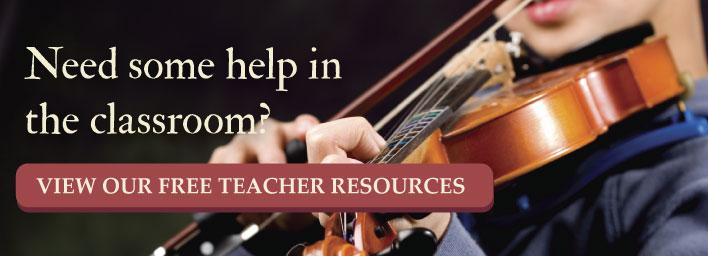How To Pick Violin Compositions That Set Your Students On Fire

One of the best ways to keep music students engaged is to provide music that inspires them - easier said than done since many beginning and intermediate violin students are children, teenagers or young adults. Often, "traditional" violin music is absent from their normal, music-listening repertoire.
The following suggestions will help you identify which music is best for which groups of - or individual - students so the music you provide nurtures their initial sparks into a fire.
Choose music that's familiar
While ear-training is essential for any musician, it's especially poignant for violin and other string players who don't have the benefit of a specific key, hole, valve or fret to press, cover, push or eyeball. Thus, choosing music your students are familiar with gives them a much better chance of recognizing when they're on note - or off.
When starting out, songs students know and recognize provides a comprehensible structure, including an awareness of where they're headed. Students experience a satisfying sense of accomplishment when able to play entire songs, (mostly) error-free, from start to finish.
Consider offering pop-music or contemporary choices
While we all love the classics, younger people enjoy the opportunity to play music that is meaningful to them. While some of your students may like nothing better than to tackle beautiful classical pieces, odds are the majority will find it more entertaining and interesting to play music that resonates with their own tastes.
Read, Top 10 Rock-and-Roll Songs for Violin, for some examples. In addition to capturing students' interest, they'll understand that violins can be just as happy in the midst of a rock band as they are in a symphony orchestra. This awareness frequently inspires lethargic students to practice more often.
Tell them a good story that connects the music to their lives
For all we pooh-pooh gadgets and modern technology, teachers know that all students still enjoy a well-told story. If you engage them with a captivating story about the pieces they're playing, the composers, the politics of the time, surprising facts about historical/societal rules or expectations, etc., - the more it will make the piece alive for them.
Mozart's Requiem, for example, is a great place to start...
Organize a trip to a live orchestral performance of the piece in question
It's difficult to avoid being captivated when seated in a live audience. Even those who claim to not like classical music find themselves rapt with attention when watching real, live symphony members warming up and performing a piece the student is learning him/herself. Students may also find themselves drawn to aspects of music and performance in a new light, such as the inherent magnetism of a symphony conductor.
If budget is an issue, speak with local symphonies about dress rehearsal options - which are often open - or can be open - to music students and classes. These sessions are free and often fit better within the school day schedule.
Is attending a live performance out of the question? Bring the performance to you via YouTube. This free music resource offers live performance videos of just about every major violin piece or orchestral composition you can think of, performed by every level of player. How fun to watch a piece performed by young orchestra members at their concert, and then the same piece by a globally-recognized symphony. It's an inspiring way to embark on your newest violin sheet music.
Select music that is both beautiful and approachable
Often, the violin scores students know best are also some of the most complicated or difficult to learn for less-experienced musicians. However, there are beautiful violin concertos that are entirely approachable for violinists who have a year or two of instruction under their belts.
Three of our favorites include:
- Concertino in the Style of Mozart, by Hans Millies
- Concerto in B Minor, Opus 35, by Oscar Rieding
- Concertino in G Major, Opus 11, by Ferdinand Küchler
When students are able to play beautiful music that sounds professional, they begin to feel more professional. All that practice and attention to technique is proven to pay off, which keeps students interested in moving further and deeper into their musicianship.
Provide a wide range of music from around the world
Virtually every culture has adapted the violin into their musical culture in one way or another, from Celtic folk groups to vibrant Mariachi bands. Don't stop with classical and European music genres - expose your students to music from around the world - and provide violin sheet music that exemplifies it. You never know when a certain style or sound will transform a student from mildly-interested to completely on board.
Avoid the temptation to provide new students with the same scores year after year. Instead, think outside the box and curate a sheet music collection that sparks inspiration and passion in your young violinists.
This article was sponsored by Thomastik-Infeld.


